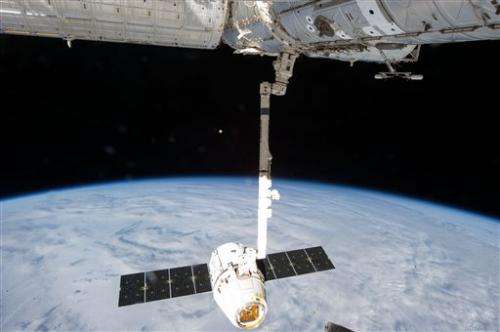Space station launch Monday despite dead computer (Update)

The International Space Station is about to get some fresh groceries and material for an urgent repair job.
An unmanned SpaceX rocket was scheduled to blast off at 4:58 p.m. (2058 GMT) Monday with more than 2 tons of supplies.
NASA spent much of the weekend debating whether to proceed with the launch of the Dragon cargo ship, already a month late. A critical backup computer failed outside the space station Friday; flight controllers were trying to activate it for a routine software load.
Mission managers decided Sunday to stick with the launch plan after making sure everything would be safe. The prime computer has been working fine so far. The plan is to put the solar wings in the proper position for the capsule's arrival soon after the SpaceX launch, in case of additional failures in orbit.
It's the first breakdown ever of one of these so-called space station MDMs, or multiplexer-demultiplexers, used to route computer commands for a wide variety of systems. Forty-five MDMs are scattered around the orbiting lab. The failed one is located outside and therefore will require spacewalking repairs.
The Dragon capsule holds a gasket-like material for next week's computer replacement. This new material was rushed to the launch site over the weekend.
NASA astronauts Rick Mastracchio and Steven Swanson will perform the job next Tuesday. It will take several days to get the replacement computer ready for installing, thus the one-week wait before the spacewalk, NASA's Kenny Todd, a station operations manager, said Monday.
SpaceX—Space Exploration Technologies Corp. of California—is one of two American companies hired by NASA to fill the cargo gap left when the space shuttles retired in 2011. Orbital Sciences Corp. of Virginia is the other.
Russia, Japan and Europe also chip in occasional cargo ships. But only the SpaceX Dragon can return a load of experiments and failed equipment back to Earth for analysis. The other cargo ships, essentially trash cans at mission's end, burn up upon re-entry.
This Dragon—the fourth one destined for the space station—also holds a new spacesuit for the six-man crew, spare parts for the spacesuits already in orbit, food, science experiments and legs for the space station humanoid, Robonaut. The experimental robot currently exists just from the waist up.
A space station astronaut almost drowned during a spacewalk last summer because of equipment failure; his helmet filled with water from the suit's cooling system. NASA wants this new spacesuit on board as quickly as possible, Todd said.
The Dragon was supposed to soar in mid-March, but was delayed first by the need for extra launch preparations and then problems with Air Force radar.
© 2014 The Associated Press. All rights reserved.





















